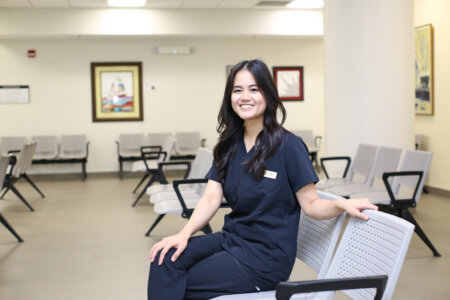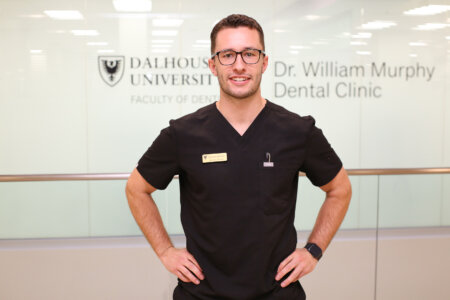
Digital dentistry improves student learning and patient care
Veronique Nguyen and Brandon Worthen are enthusiastic about digital dentistry techniques and their impact on the patient experience. With access to the latest technologies, dentistry and dental hygiene students can graduate with a higher level of career readiness.
By Cheryl Bell
For Veronique Nguyen and Brandon Worthen, the future of oral health care is digital. During their studies in the Faculty of Dentistry, the two senior students have had the opportunity to work hands-on with the digital intraoral scanning equipment and can see the benefits for both patients and oral health care providers.

Photo by Bruce Bottomley
Originally from Winnipeg, where she had been studying to be a psychiatric nurse, Veronique Nguyen came to Nova Scotia to pursue a diploma of dental hygiene (DDH). She knew she wanted to be in a health-care profession and dental hygiene appealed because it offered the opportunity for longer term patient relationships and the kind of work-life balance she was looking for.
In the second year of the DDH program, Nguyen has had the opportunity to get hands-on experience with the Faculty’s digital dentistry equipment. What she saw convinced her that the equipment has a significant role to play in dental hygiene.
“As a dental hygienist, I can use that technology to capture tooth and soft tissues in one go,” she says. It’s also good for record-keeping, patient education, treatment planning, and referrals. She says the records can readily show the progression of gingival recession or a fracture.
Getting patients involved in their oral health
What Nguyen believes is particularly beneficial, however, is the opportunity to get patients more engaged in their oral health by showing them scans and photos of their oral cavity on the screen. And by using a wand to scan patients’ mouths rather than the often-dreaded alginate impressions, patient fear and anxiety can be alleviated.
What does she find most exciting about digital dentistry? How environmentally friendly it is. “Waste management is one of the big challenges we face together in this world,” she says. “With digital dentistry, I appreciate that we can take measures to reduce that waste.”
Happy to help people
As a junior A hockey player, Brandon Worthen saw his share of facial and dental injuries. But that wasn’t what put him on the path to being a dentist. The inspiration lay closer to home. His father, Terry (DDS’96), and brother, Josh (DDS’23) are both dentists, and his aunt, Grace Richardson (DDS’01), is an orthodontist. Worthen says that his dad always came home from work happy to have helped people. By his second year of university, he knew dentistry was in his future, too.

Photo by Bruce Bottomley
Although Worthen has been introduced to digital dentistry in class, most of the experience he now has was the result of summer research projects carried out with Dr. Chris Lee, an assistant professor in the Faculty of Dentistry.
In the summer after his first year of dental school, Worthen helped to scan stone models as part of the process of digitizing patient records, becoming adept at using the scanning wand as a result. After his second year, his summer project involved evaluating the accuracy of the digital scanners.
Like Nguyen, Worthen sees the benefits of digital equipment in the Faculty of Dentistry as a teaching tool and for patient care. He says the technology is useful for learning tooth anatomy, and evaluating the quality of your work, such as crown preparations. “You can do a scan of your prep, blow the image up on the screen, and get instant, objective feedback on how good it is,” says Worthen.
When it comes to patient care, he says that the technology makes a lot of procedures “quicker, easier, more accurate, and more comfortable”. Reducing the number of patient appointments is also a great advantage. For a crown produced using conventional methods, for example, it can take multiple appointments, especially if refinements are needed. With digital technology, the preparation, scanning, milling, and fitting can all take place in one appointment.
Making a good impression
Worthen believes that “everything starts with a good impression” and digital technology makes it easier to capture that. Partials, retainers, bite guards, surgical guides for implants, and even complete sets of dentures can now all be made quickly and with great accuracy. Having a digital file of a denture or retainer means that a new appliance can simply be printed and sent to the patients, without the need for multiple appointments. Digital dentistry is also allowing general dentists to do more and be more comfortable with orthodontics and clear aligner treatment.
Another positive impact of the new technology is that working with the labs that do the 3D printing is much more efficient. “You’re all speaking the same digital language,” he explains, “and by providing the labs with accurate scans, you’re helping to limit the amount of tweaking they have to do to make something work.”
Both Nguyen and Worthen know that digital technology will be a large part of their lives as oral health care providers. Clean, fast, precise, and efficient, digital dentistry offers a bright and exciting future. “We’re coming into this at a good time,” says Worthen.
Donor support has enabled the Faculty of Dentistry to acquire eight pre-clinical omnicams, four primescans, two milling units, and two 3D printers. Further investment in this technology will enable the Faculty of Dentistry to continue to expand its digital capacity, improve teaching and clinical treatments, and create new opportunities for innovation.
 Donations to the
Donations to the